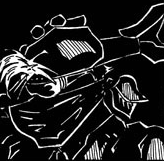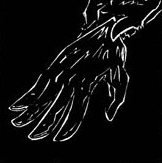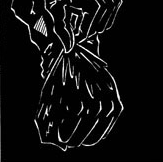It’s no secret that superhero comics comprise a large percent of traditional print comics. So it’s not surprising that this genre would migrate to the web as well. The superhero genre is one that we all have a familiarity with, and we like it to different degrees. The genre is also highly self-derivative, borrowing heavily from within its own ranks. Writers and artists recycle and repackage character archetypes, plots, and relationships often, with varying degrees of success. The greatest succeed by creating strong stories and characters that evolve beyond the initial archetype. Problems can arise, however, when new work borrows more than it creates.
Which brings us to Saga of the Ram, created by Brian Daniel. At best, it’s a superhero story with weak story lines that fall into the trap of using established superhero clichés (e.g. best friend as sidekick, girlfriend in the dark about secret identity, one or more parents dead) to define the main character and his supporting cast. At worst, it can be viewed as a rehashed world created by a superhero fan, incorporating many elements from pre-existing print superhero comics.
 Rick Maine is at the center of this story, and we are introduced to him via his origin tale. Rick and his sister Marianne are raised in a single family home after the death of their father (who was the first person to take on the moniker "The Ram"). Rick decides to make it a family business after discovering his dad’s sanctum sanctorum by accident within the family home. His best friend Jamie – who was fostered by the family, serves for a large part of the story as a sidekick to his best buddy, Rick. While on his first wacky crime-fighting caper, Rick saves his soon-to-be sweetie, Ariel. As the chapters progress, we follow Rick and his crusades against reappearing super villain Cashmere, the local crime syndicate, Death, a wacky mad scientist who’s also the head of a crime family, supra criminals, supra humans, and a professional thief (bad girl with a heart of gold) that doubles as a secondary love interest.
Rick Maine is at the center of this story, and we are introduced to him via his origin tale. Rick and his sister Marianne are raised in a single family home after the death of their father (who was the first person to take on the moniker "The Ram"). Rick decides to make it a family business after discovering his dad’s sanctum sanctorum by accident within the family home. His best friend Jamie – who was fostered by the family, serves for a large part of the story as a sidekick to his best buddy, Rick. While on his first wacky crime-fighting caper, Rick saves his soon-to-be sweetie, Ariel. As the chapters progress, we follow Rick and his crusades against reappearing super villain Cashmere, the local crime syndicate, Death, a wacky mad scientist who’s also the head of a crime family, supra criminals, supra humans, and a professional thief (bad girl with a heart of gold) that doubles as a secondary love interest.
The stories are hit-and-miss at times. Daniel’s writing and characterization is strongest when he is writing his characters not as superheroes, sidekicks, or villains, but as real people interacting with one another or performing extraordinary acts of bravery.
The story where Jerod encounters his real father is also written well (even though it has super-power elements to it). This is a person who just wants to be normal, and the writing is convincing enough that you not only believe it, but you feel sympathy for the character. Or when Jamie, not The Ram, saves the day sans superpowers during this storyline. The subplot dealing with Marianne’s pregnancy and Jamie’s decision to accept responsibility for a child that isn’t his is handled delicately.
 Which brings up a very good question: why does Daniel handle the relationship between Ariel and Rick so weakly? Saga of the Ram resorts to one of the most over-used, trite clichés when dealing with Rick and Ariel’s relationship – don’t tell your sweetie about your vigilante ways, because as a result they might get hurt or killed, or run away from you, etc., etc.
Which brings up a very good question: why does Daniel handle the relationship between Ariel and Rick so weakly? Saga of the Ram resorts to one of the most over-used, trite clichés when dealing with Rick and Ariel’s relationship – don’t tell your sweetie about your vigilante ways, because as a result they might get hurt or killed, or run away from you, etc., etc.
For once, in a superhero story, it would be nice if the writer discarded this kind of bunk. This is predictable, bad drama, and it really weakens the believability of Rick and Ariel’s relationship, especially when the main character’s initial role models (Rick’s mom and dad) co-existed without it. Having tension related to the fact that he or she does know what the other (crime-fighting) half is doing would be a better method for working in romantic conflict. Life in general is unpredictable and filled with moments and events, both bad and good – regardless of whether or not you’re an average joe or superhero. Your sweetie could get hit by a bus tomorrow, and die. Or get sick, and die. Or leave you because the relationship isn’t working. Or leave because her life is taking her in another direction. The possibilities are endless.
The first five chapters, available for free, are hard to follow, mainly because the artist uses the same heavy–handed, thick approach to his character outlines, along with an over-reliance on small, identical thin lines to create texture. This page contains an example of the problem. Panel 1 shows us an aerial view of the Maine residence. There’s a house on a hill overlooking a large body of water. The lines used to define the water, the beach, and the land (including hill) all register as being on the same level. The only two visual clues we have that there is something separating the far ground (water) from the mid-ground (beach) and the foreground (hill) are the dots used to signify sand, and the fence used to separate the house from the hill. The house has no deep shadow on the side facing away from the water, and likewise it casts no shadow across the grass.
 Panel 2 (at first glance) appears to be a close up shot of Rick in bed: we see his face, the sheet covering him, and the pillow behind his head. What looks like the pillow behind his head is actually part of his shoulder – the actual pillow is what appears to be sheets in the lower half of this panel. The reason we know this is in Panel 3, we are pulled back from the bed to see that Rick is lying on his stomach. The lines that define Rick, the bed, the sheets, Jamie, and the door are all at the same width, which makes understanding this image difficult at first glance. Likewise, the figures of Rick and Jamie in panel 4 suffer from the same problem. Jamie is clearly closer to the viewer than Rick, however both figures are rendered as if they were at the same distance from the viewer within the frame.
Panel 2 (at first glance) appears to be a close up shot of Rick in bed: we see his face, the sheet covering him, and the pillow behind his head. What looks like the pillow behind his head is actually part of his shoulder – the actual pillow is what appears to be sheets in the lower half of this panel. The reason we know this is in Panel 3, we are pulled back from the bed to see that Rick is lying on his stomach. The lines that define Rick, the bed, the sheets, Jamie, and the door are all at the same width, which makes understanding this image difficult at first glance. Likewise, the figures of Rick and Jamie in panel 4 suffer from the same problem. Jamie is clearly closer to the viewer than Rick, however both figures are rendered as if they were at the same distance from the viewer within the frame.
Midway through the first five chapters, the art shifts from black & white to greyscale, which helps to define characters and objects within the panel. The artwork is still busy, but at least with shading it’s easier on the eyes. Chapters 1-5 rely on a standard page size for laying out panels. This style changes for the better in"A Night with Detective Graywolf" through to the current chapter. No longer restricted to a page format, the panels flow downward in an unrestricted manner, allowing each panel more breathing room atop a uniform black background. This method of displaying panels is enhanced by the introduction of full-color. Full-time colorist Richard Wyatt does an excellent job of coloring the pages, and his work adds a nice element to the art.
 Saga of the Ram is what it claims to be: a standard superhero story. And the story has been running for quite some time, as the archives on both Purrsia and Graphic Smash prove. But it overlooks the spark of what can make a superhero story great: a clever blending of the fantastic and the real. It comes close to achieving this in places, but doesn’t quite make that goal on a regular basis.
Saga of the Ram is what it claims to be: a standard superhero story. And the story has been running for quite some time, as the archives on both Purrsia and Graphic Smash prove. But it overlooks the spark of what can make a superhero story great: a clever blending of the fantastic and the real. It comes close to achieving this in places, but doesn’t quite make that goal on a regular basis.
When she’s not dealing with irate law students who owe library books, Sahsha can be found writing and illustrating her own webcomic, Nekko and Joruba.
Recent Comments